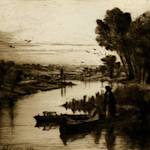One Step Forward - Or Back.
Personal memory by Susan Goodall
1972 • Big Moose Lake, New York 13331, USA
The loons were still there, barely, in 1972. Big Moose Lake in the Adirondacks. In the blue twilight you could hear them calling - or were they laughing at us. The smallest tree frogs still hopped in the moss between the pines. We crafted alternate universes for them in our bathtub, holding them oh so very gentle in our hands so as not to crush their tiny legs. And the perch and catfish could still be caught although the trout, harbingers of lake health, could not. Ten years later and the loons had disappeared, the tiny frogs were gone and only catfish surfaced. Acid rain. By 1976, when all the acidified lakes in the Park were cataloged, researchers found that half of the lakes over 2,000 feet above sea level had no fish. Twenty years later legislation, communal action and the efforts to add lime to the lake and seed the trout, have all made a difference. But trout thrive in cold glacial lake water. Will global warming be their undoing?


Learn about Maya Lin’s fifth and final memorial: a multi-platform science based artwork that presents an ecological history of our world - past, present, and future.

Discover ecological histories and stories of former abundance, loss, and recovery on the map of memory.

Learn how we can reduce our emissions and protect and restore species and habitats – around the world.

See how art can help us rethink the problems we face, and give us hope that each one of us can make a difference.

Help make a global memorial something personal and close to home. Share your stories of the natural world.


